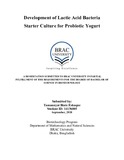| dc.contributor.advisor | Hossain, Dr. M. Mahboob | |
| dc.contributor.author | Eshaque, Tamannyat Binte | |
| dc.date.accessioned | 2018-12-02T07:49:34Z | |
| dc.date.available | 2018-12-02T07:49:34Z | |
| dc.date.copyright | 2018 | |
| dc.date.issued | 2018-09 | |
| dc.identifier.other | ID 14136005 | |
| dc.identifier.uri | http://hdl.handle.net/10361/10929 | |
| dc.description | This thesis is submitted in partial fulfilment of the requirements for the degree of Bachelor of Science in Biotechnology, 2018. | en_US |
| dc.description | Cataloged from PDF version of thesis. | |
| dc.description | Includes bibliographical references (page 58-61). | |
| dc.description.abstract | Lactobacillales or lactic acid bacteria (LAB) are one of the most numerous groups of bacteria
linked to humans. Lactic acid bacteria show antimicrobial properties and these are generally
recognized as safe (GRAS). The primary antimicrobial effect exhibited by the LAB is the
production of lactic acid and a lower pH. In recent years, it has been seen that, several
pathogenic bacteria are getting resistant to multiple antibiotics. In such conditions, new
probiotics with potential antimicrobial properties can play an important role. In the present study,
the industrially important lactic acid bacteria are mainly focused with the purpose of creating a
probiotic starter culture. The study started with 20 isolates of LAB isolated from fermented
vegetables and dairy products from the previous project. Among them 10 isolates were selected
with maximum growth on MRS media. The antagonistic activity of these isolates was monitored
using several parameters. The agar well diffusion results zone of inhibition with the cell-free
supernatant of LAB isolates derived from Cauliflower, Carrot, Cabbage, Brinjal, Aarong yogurt,
Dhaka cheese against indicator organisms Streptococcus agalactiae, Streptococcus pyogenes,
Streptococcus pneumoniae, Bacillus subtilis, Bacillus cereus, Shigella dysenteriae, Shigella
flexneri, Klebsiella sp., Enterobacter cloacae, and Salmonella typhi. Measured pH of cell-free
supernatant and MRS broth was in higher range.
The aim of this study is to find out antimicrobial properties present in LAB strains isolated from
fermented vegetables and dairy products and developing an economically affordable probiotic
yogurt starter culture. The production of probiotic yogurt starter culture involved inoculating
three types of milk: whole milk, skimmed milk and powdered milk with the LAB isolates. Four
hours to an overnight incubation at 30-40 ºC showed desired yogurt production. Further
dehydration of a portion of the yogurt at 65 ºC for 2-3 hours gave yogurt powder. Finally
addition of the produced yogurt powder into milk sample resulted in yogurt again. Such yogurt
powder can be industrially manufactured at a low cost in developing countries where the
consumption of probiotic products is growing intensively. Consumption of active probiotic
yogurt can eventually lessen the intake of traditional antibiotics. | en_US |
| dc.description.statementofresponsibility | Tamannyat Binte Eshaque | |
| dc.format.extent | 65 pages | |
| dc.language.iso | en | en_US |
| dc.rights | BRAC University theses are protected by copyright. They may be viewed from this source for any purpose, but reproduction or distribution in any format is prohibited without written permission. | |
| dc.subject | Yogurt | en_US |
| dc.subject | Lactic acid | en_US |
| dc.subject.lcsh | Yogurt--Health aspects. | |
| dc.subject.lcsh | Lactic acid bacteria. | |
| dc.title | Development of Lactic Acid bacteria starter culture for probiotic yogurt | en_US |
| dc.type | Thesis | en_US |
| dc.contributor.department | Department of Mathematics and Natural Sciences, BRAC University | |
| dc.description.degree | B. Biotechnology | |

